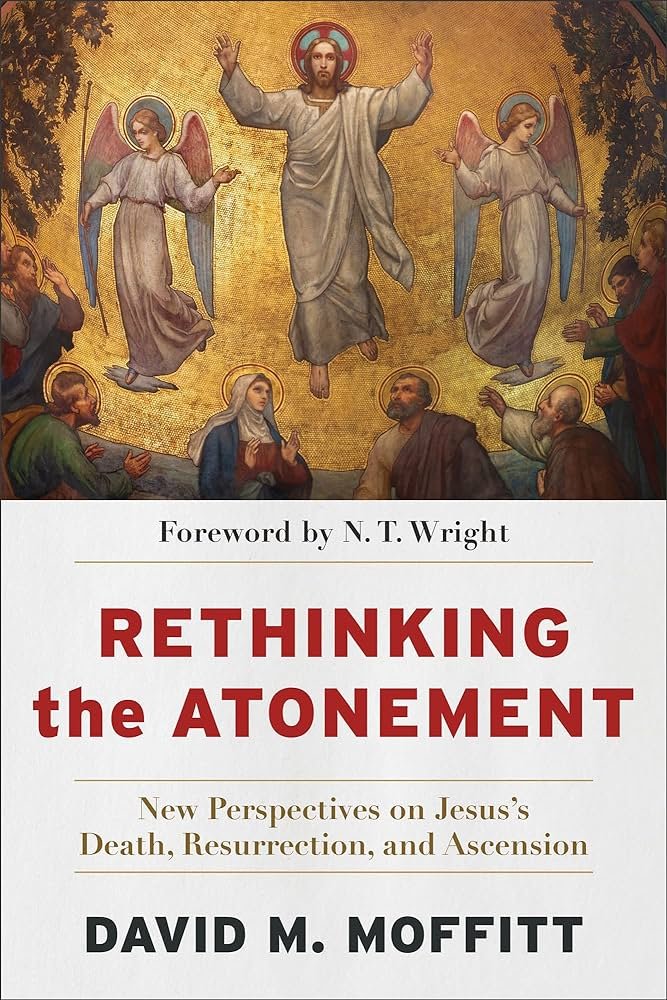The views expressed in this article are of the author only and do not necessarily represent those of the Center for Pastor Theologians.
Rethinking the Atonement: New Perspectives on Jesus’s Death, Resurrection, and Ascension
David Moffitt
Baker Academic (2022). 320 pp.
David Moffitt’s Rethinking the Atonement provides a perceptive and insightful contribution to the ongoing discourse on the Christian doctrine of atonement. As Reader in New Testament Studies at the University of St. Andrews and a leading researcher in Hebrews scholarship, Moffitt is well-positioned to elevate the importance of Hebrews in contemporary debates on atonement, which have often focused on the Pauline epistles and the Gospels. Indeed, Moffitt devotes a significant portion of the book to an in-depth analysis of the Epistle to the Hebrews, occupying more than two-thirds of the text. This emphasis on Hebrews is so central to Moffit’s argument that the book could have easily been titled Rethinking the Atonement in Hebrews, were it not for the final 83 pages devoted to other NT texts.
The book is divided into fifteen chapters, each of which (apart from chapters 1, 4 and 10) is a republication of some of Moffit’s most significant articles. The first ten are devoted to an in-depth analysis of the Epistle to the Hebrews. Moffitt explores key themes of atonement such as Jesus’s death (chapter 2), the inauguration of the New Covenant (chapter 3), Jesus’s resurrection (chapter 5), Yom Kippur (chapter 6), Mosaic Law (chapter 7), analogical theology as means to understand Jesus’s service at the heavenly tabernacle (chapter 8), and Jesus’s perpetual work as the heavenly high priest (chapter 9). Throughout this section, Moffitt emphasizes that Jewish apocalypticism, rather than Platonic idealism, is the most appropriate way to understand Hebrews’ theology of atonement. In chapter 11, he concludes his focus on Hebrews by providing a brief analysis of Early Christian reception of Jesus’s heavenly sacrifice. The remaining chapters are dedicated to analyzing atonement in Matt 12 (chapter 13) and 27 (chapter 12), Acts (chapter 14), and 1 Cor 15 (chapter 15).
Moffitt’s aim in writing this book is apparent from the opening chapter, in which he posits that Jesus’s sacrificial atonement extends beyond his death on the cross to include his resurrection and ascension. He draws extensively from his earlier work, Atonement and the Logic of Resurrection in the Epistle to the Hebrews (Brill, 2011), to argue that the Hebrew Bible’s sacrificial system involved a multi-step process, with the spilling of animal blood being only one part of a more comprehensive ritual culminating in the offering being presented to God inside the temple. Considering this, Moffitt contends that when Hebrews speaks of Jesus’s atoning sacrifice, it does not simply refer to the event of his death, but also encompasses his resurrection, ascension, and his presentation of himself as the sacrifice on behalf of humanity at the heavenly tabernacle. To quote Moffitt’s own words, “The resurrection and ascension are not just important addenda to the main event of the crucifixion . . . Rather, Jesus’s resurrection and ascension are themselves fully and robustly salvific . . . the goal of many of these essays is to show that Jesus’ death, resurrection, and ascension are all atoning” (p. 5).
The book’s central claim has been criticized by some, particularly among Protestant circles, thinking it undermines the significance of the cross. If Jesus’s death is not the definite time when atonement is secured, Moffitt’s view runs the risk of depicting Jesus’s death as not really “finishing” anything at the cross, as John 19:30 states. In response, Moffitt takes care to address this concern throughout the book. He clarifies that he is not seeking to diminish the importance of the cross, as though Jesus’s death is a lesser event, but rather that atonement is a multi-step process that extends beyond Jesus’s death. At one point, Moffitt clarifies that the fact that Hebrews does not conceive of Jesus’s atonement as being completed at the cross, “does not mean that Jesus’ death/work on the cross is not salvific. The point, rather, is that Jesus does more to effect salvation than simply die.” (p. 137, n. 7). While Jesus’s death is certainly a vital component of his sacrifice, Jesus’s salvific work would be incomplete without a larger sequence of events, including his resurrection and ascension.
In conclusion, David Moffitt’s Rethinking the Atonement offers a fresh perspective on the Christian doctrine of atonement, with a particular emphasis on the book of Hebrews. By drawing on his extensive research in Hebrews scholarship, Moffitt challenges traditional views of atonement that focus solely on Jesus’s death on the cross. Although his view has been criticized for potentially undermining the significance of the cross, Moffitt addresses this concern throughout the book and clarifies that Jesus’s death remains a vital component of his sacrifice. Overall, it is a valuable contribution to ongoing discussions on atonement theology and is recommended reading for scholars and students alike.
Alberto Solano Zatarain is an assistant minister at Oxford Presbyterian Church and a DPhil candidate in New Testament at the University of Oxford. He is a member of the St. Hildegarde Fellowship of the Center for Pastor Theologians.




